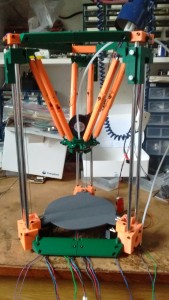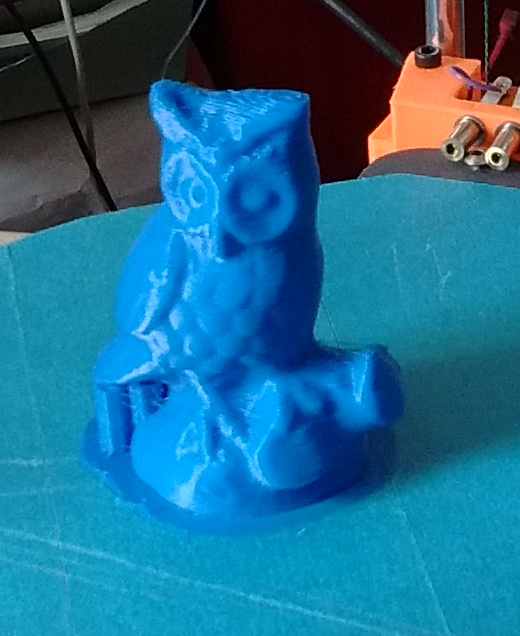As followers of this blog will know I have been working on a new RepRap delta design – Lorenz. It has a number of novel features and it also contains a very high proportion of self-printed parts. I haven’t finished it yet, and here is a picture of it finished.
What? Well. Because of the brilliance of open source (Lorenz is here on Github) Tim Williams downloaded what I had done, finished it and got it working. Here is his Lorenz’s first print:
Tim writes:
“The green prints were made on a Fisher and I managed to pull through the wire conduits. The orange prints were made on another delta and, probably due to my slicer settings, although the dimensions were correct, the wire conduits to the smooth tubes were blocked. I managed to use the concealed wiring runs for the print bed contacts but not for the limit switch connections. These wires I had to run down one tower tube. A pity as this seems a very useful technique.
“The tubes were 8mm aluminium (which I had in stock) brought to a high polish finish, and so far work well with the PTFE runners.
“I tried to fit stainless steel wire on 12mm acetal drums, but I failed miserably! (it seems to spring everywhere). So I reverted to Spectra braid which I have used before and is rather more manageable. Spectra being slightly waxy slipped under the slider grub screws, so I had to resort to some fancy knot work.
“I cut the print bed from 4mm marine ply and this with the aluminium tubes produced a very compact, light printer with, as I judge, fairly good rigidity.
“The electronics is a Duet 0.6 and the firmware/software pretty much that used on the Fisher, with some calibration changes. Using the same slicing settings as for the Fisher, calibration cubes were very comparable. The Lorenz produced very slight ghosting and the towers could probably do with further calibration.
“If I were starting again I would take more care printing the top/bottom blocks and possibly machine a fine thread on the acetal drums to aid winding the SS wire. (Tho’ this adds complexity to the build).
“In general, I do not think I have added much to your design. If others are interested I would be ready to join a discussion forum.”
My solution to the steel wire problem that Tim mentions is to secure the wire with small slivers of Kapton tape, which I then peel off with forceps when the drum is in the axis assembly. I used brass, not acetyl, for the drums.
I’d like to finish this post by thanking Tim. I have not had time to finish Lorenz because of other work, and he has done a great job. Not only has he cut a path for others to follow, his work also means that – when I get back to the RepRap Lorenz Project (to write the documentation, for example…) – I will do so with added confidence that what I am doing will succeed.
Adrian
UPDATE – There is a
Facebook group set up for Lorenz development and discussion.
Connect with us
Keep up to date on the latest RepRap Ltd news:



